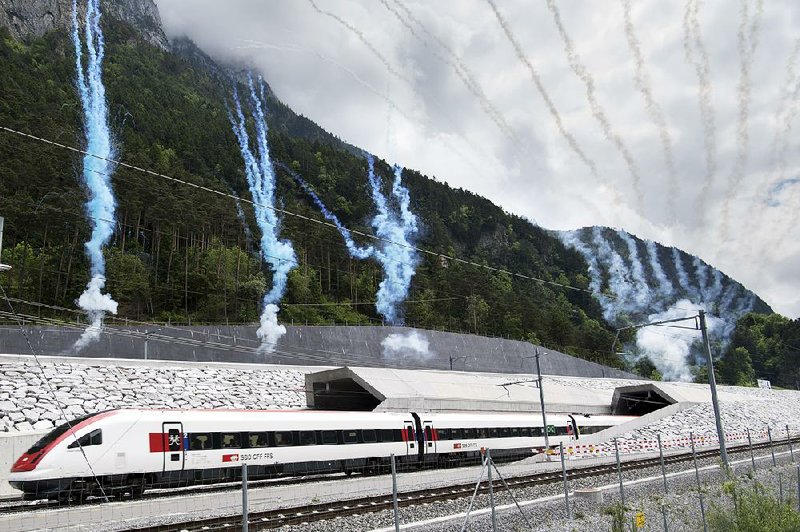GENEVA -- European dignitaries on Wednesday officially opened the 35.4-mile Gotthard Railway Tunnel, a major engineering achievement deep beneath the Alps.
It took 17 years to build at a cost of $12 billion -- but workers kept to a key Swiss tradition and brought the project in on time and on budget.
Many tunnels crisscross the Swiss Alps. The Gotthard Pass itself already has two -- the first, also for trains, was built in 1882. But the Gotthard base tunnel is a record setter, eclipsing Japan's 33.4-mile Seikan Tunnel as the world's longest -- and it also bores deeper than any other tunnel, running about 1.4 miles underground at its maximum depth.
The tube bores through the Gotthard massif that includes the 8,200-foot Piz Vatgira on the way to Italy. It is part of a broader, multitunnel project to shift the haulage of goods from roads to rails amid concerns that heavy trucks are destroying Switzerland's pristine Alpine landscape.
The thoroughfare aims to cut travel times, ease roadway traffic and reduce the air pollution spewed from trucks traveling between Europe's north and south. Set to open for commercial service in December, the two-way tunnel can handle up to 260 freight trains and 65 passenger trains per day.
Swiss planners have dreamed of such a tunnel for decades, and Gotthard's 17 years of construction don't include the many years spent to scope out suitable paths.
Switzerland pulled out all the stops for Wednesday's inauguration. Chancellor Angela Merkel of Germany, President Francois Hollande of France and Italian Prime Minister Matteo Renzi all went to southern Switzerland for an upbeat, glitzy celebration featuring bands, dancers and even a theme song for the tunnel.
Under purple neon lights, performers dressed in orange miners' suits and protective helmets danced atop a moving rail car, while others in skimpy outfits feigned wrestling, and trapeze artists hung from chains or ropes.
The tunnel runs between the German-speaking Swiss town of Erstfeld in the north to the Italian-speaking town of Bodio in the south, cutting through central Switzerland. The tunnel journey takes about 20 minutes for passenger trains.
Split-screen TV images Wednesday showed two trains in opposite directions entering and leaving the tunnel entrances nearly simultaneously.
The project, funded in part by Swiss taxpayers and fees on trucks, received financial support and industrial know-how from around the European Union. Although Switzerland isn't one of the bloc's 28 members, the EU railway network benefits from this shortcut through the Alps, notably on the route from Germany to Italy.
"The new tunnel fits into the European railway freight corridor, which links Rotterdam and Genoa" -- key ports in the Netherlands and Italy, said Swiss President Johann Schneider-Ammann. "Aside from saving time, more merchandise can be carried through the Alps."
A test run by the EU leaders on Wednesday turned into a sort of minisummit beneath real Alpine summits: Merkel, Renzi, Hollande and Schneider-Ammann sat face-to-face for a ride in first class through the tunnel. A band played Rossini's William Tell Overture after they arrived.
Merkel said it was a "wonderful feeling" to be on the train. Though "more than 2,000 meters of rocks" were above, she said she felt a "feeling of security, because I believe in the security of the Swiss civil engineers."
She congratulated the punctual Swiss and noted how costs were kept within targets.
"That's something Germany still needs to strive for," she said.
Hollande, host of the U.N. climate-change summit held in Paris last year, pointed to the tunnel's environmental benefits.
"You have created a great European infrastructure," Hollande said at the tunnel's southern exit. "It will be able to reduce greenhouse-gas emissions, redirect traffic from the road to rail and move passengers and goods faster."
He also used the chance to remind Britons of the unity that the tunnel under the English Channel has brought between Britain and the continent -- comments that came just weeks before Britons vote June 23 on whether to stay in the EU or leave.
"More than 20 years ago, a construction was completed between France and the United Kingdom: The Channel Tunnel," Hollande said. "Since then, we are united like never before, and I hope the British remember that when the time comes."
Renzi echoed that connective symbolism, despite the current discord in the EU over how to best handle a surge of migrants from the Middle East, Africa and Asia.
"At a time when some are thinking about building walls ... today Switzerland gives us a beautiful signal about building a tunnel, connecting, and making chances for meeting," Renzi said.
Swiss forces took no chances with security for the inauguration. Almost 2,000 additional Swiss troops were called, helicopters buzzed overhead, and airspace restrictions were put over the tunnel area.
Information for this article was contributed by Kirsten Grieshaber and Nicole Winfield of The Associated Press.
Business on 06/02/2016

